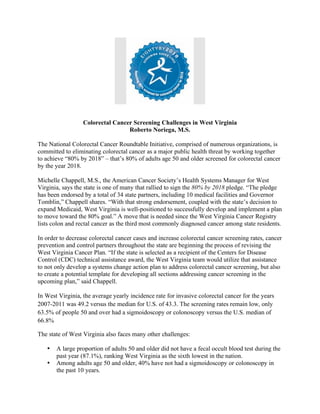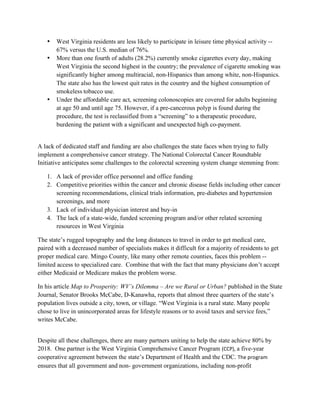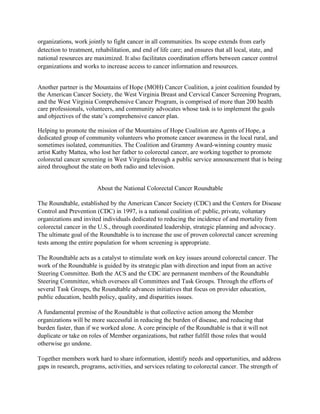WV Medical Journal article FINAL-1
- 1. Colorectal Cancer Screening Challenges in West Virginia Roberto Noriega, M.S. The National Colorectal Cancer Roundtable Initiative, comprised of numerous organizations, is committed to eliminating colorectal cancer as a major public health threat by working together to achieve ŌĆ£80% by 2018ŌĆØ ŌĆō thatŌĆÖs 80% of adults age 50 and older screened for colorectal cancer by the year 2018. Michelle Chappell, M.S., the American Cancer SocietyŌĆÖs Health Systems Manager for West Virginia, says the state is one of many that rallied to sign the 80% by 2018 pledge. ŌĆ£The pledge has been endorsed by a total of 34 state partners, including 10 medical facilities and Governor Tomblin,ŌĆØ Chappell shares. ŌĆ£With that strong endorsement, coupled with the stateŌĆÖs decision to expand Medicaid, West Virginia is well-positioned to successfully develop and implement a plan to move toward the 80% goal.ŌĆØ A move that is needed since the West Virginia Cancer Registry lists colon and rectal cancer as the third most commonly diagnosed cancer among state residents. In order to decrease colorectal cancer cases and increase colorectal cancer screening rates, cancer prevention and control partners throughout the state are beginning the process of revising the West Virginia Cancer Plan. ŌĆ£If the state is selected as a recipient of the Centers for Disease Control (CDC) technical assistance award, the West Virginia team would utilize that assistance to not only develop a systems change action plan to address colorectal cancer screening, but also to create a potential template for developing all sections addressing cancer screening in the upcoming plan,ŌĆØ said Chappell. In West Virginia, the average yearly incidence rate for invasive colorectal cancer for the years 2007-2011 was 49.2 versus the median for U.S. of 43.3. The screening rates remain low, only 63.5% of people 50 and over had a sigmoidoscopy or colonoscopy versus the U.S. median of 66.8% The state of West Virginia also faces many other challenges: ŌĆó A large proportion of adults 50 and older did not have a fecal occult blood test during the past year (87.1%), ranking West Virginia as the sixth lowest in the nation. ŌĆó Among adults age 50 and older, 40% have not had a sigmoidoscopy or colonoscopy in the past 10 years.
- 3. ŌĆó West Virginia residents are less likely to participate in leisure time physical activity -- 67% versus the U.S. median of 76%. ŌĆó More than one fourth of adults (28.2%) currently smoke cigarettes every day, making West Virginia the second highest in the country; the prevalence of cigarette smoking was significantly higher among multiracial, non-Hispanics than among white, non-Hispanics. The state also has the lowest quit rates in the country and the highest consumption of smokelessŌĆ®tobacco use. ŌĆó Under the affordable care act, screening colonoscopies are covered for adults beginning at age 50 and until age 75. However, if a pre-cancerous polyp is found during the procedure, the test is reclassified from a ŌĆ£screeningŌĆØ to a therapeutic procedure, burdening the patient with a significant and unexpected high co-payment. A lack of dedicated staff and funding are also challenges the state faces when trying to fully implement a comprehensive cancer strategy. The National Colorectal Cancer Roundtable Initiative anticipates some challenges to the colorectal screening system change stemming from: 1. A lack of provider office personnel and office funding 2. Competitive priorities within the cancer and chronic disease fields including other cancer screening recommendations, clinical trials information, pre-diabetes and hypertension screenings, and more 3. Lack of individual physician interest and buy-in 4. The lack of a state-wide, funded screening program and/or other related screening resources in West Virginia The stateŌĆÖs rugged topography and the long distances to travel in order to get medical care, paired with a decreased number of specialists makes it difficult for a majority of residents to get proper medical care. Mingo County, like many other remote counties, faces this problem -- limited access to specialized care. Combine that with the fact that many physicians donŌĆÖt accept either Medicaid or Medicare makes the problem worse. In his article Map to Prosperity: WVŌĆÖs Dilemma ŌĆō Are we Rural or Urban? published in the State Journal, Senator Brooks McCabe, D-Kanawha, reports that almost three quarters of the stateŌĆÖs population lives outside a city, town, or village. ŌĆ£West Virginia is a rural state. Many people chose to live in unincorporated areas for lifestyle reasons or to avoid taxes and service fees,ŌĆØ writes McCabe. Despite all these challenges, there are many partners uniting to help the state achieve 80% by 2018. One partner isŌĆ®the West Virginia Comprehensive Cancer Program (CCP),ŌĆ®a five-year cooperative agreement between the stateŌĆÖs Department of Health and the CDC. TheŌĆ®programŌĆ® ensures that all government and non- government organizations, including non-profit
- 4. organizations, work jointly to fight cancer in all communities. Its scope extends from early detection to treatment, rehabilitation, and end of life care; and ensures that all local, state, and national resources are maximized. It also facilitates coordination efforts between cancer control organizations and works to increase access to cancer information and resources.ŌĆ® Another partner is the Mountains of Hope (MOH) Cancer Coalition, a joint coalition founded by the American Cancer Society, the West Virginia Breast and Cervical Cancer Screening Program, and the West Virginia Comprehensive Cancer Program, is comprised of more than 200 health care professionals, volunteers, and community advocates whose task is to implement the goals and objectives of the stateŌĆÖs comprehensive cancer plan. Helping to promote the mission of the Mountains of Hope Coalition are Agents of Hope, a dedicated group of community volunteers who promote cancer awareness in the local rural, and sometimes isolated, communities. The Coalition and Grammy Award-winning country music artist Kathy Mattea, who lost her father to colorectal cancer, are working together to promote colorectal cancer screening in West Virginia through a public service announcement that is being aired throughout the state on both radio and television. About the National Colorectal Cancer Roundtable The Roundtable, established by the American Cancer Society (CDC) and the Centers for Disease Control and Prevention (CDC) in 1997, is a national coalition of: public, private, voluntary organizations and invited individuals dedicated to reducing the incidence of and mortality from colorectal cancer in the U.S., through coordinated leadership, strategic planning and advocacy. The ultimate goal of the Roundtable is to increase the use of proven colorectal cancer screening tests among the entire population for whom screening is appropriate. The Roundtable acts as a catalyst to stimulate work on key issues around colorectal cancer. The work of the Roundtable is guided by its strategic plan with direction and input from an active Steering Committee. Both the ACS and the CDC are permanent members of the Roundtable Steering Committee, which oversees all Committees and Task Groups. Through the efforts of several Task Groups, the Roundtable advances initiatives that focus on provider education, public education, health policy, quality, and disparities issues. A fundamental premise of the Roundtable is that collective action among the Member organizations will be more successful in reducing the burden of disease, and reducing that burden faster, than if we worked alone. A core principle of the Roundtable is that it will not duplicate or take on roles of Member organizations, but rather fulfill those roles that would otherwise go undone. Together members work hard to share information, identify needs and opportunities, and address gaps in research, programs, activities, and services relating to colorectal cancer. The strength of
- 5. such a partnership, united in mission, enhances the work of each member and thus effectively furthers the cause of colorectal cancer prevention in the United States. For more information about the NCCRT visit: http://nccrt.org/contact-us To sign the pledge: Reaching 80% Screened for Colorectal Cancer by 2018, visit: http://nccrt.org/wp-content/uploads/80by2018Commitmment.pdf References 1. American Cancer Society. Topic Page. http://www.cancer.org/cancer/colonandrectumcancer/. January 2015. 2. Centers for Disease Control and Prevention. Topic Page. http://www.cdc.gov/cancer/colorectal/. January 2015. 3. United States Preventive Services Task Force. Topic Page. http://www.uspreventiveservicestaskforce.org/uspstf/uspscolo.htm. January 2015. 4. West Virginia Cancer Registry, 2007-2011. 5. West Virginia Health Statistics Center, Vital Statistics System, 2011. 6. NCSL (National Conference of State Legislatures). Topic Page. http://www.ncsl.org/research/health/mandated-health-insurance-benefits-and-state- laws.aspx. January 2015. 7. WV Code, ┬¦33-24-7f .




